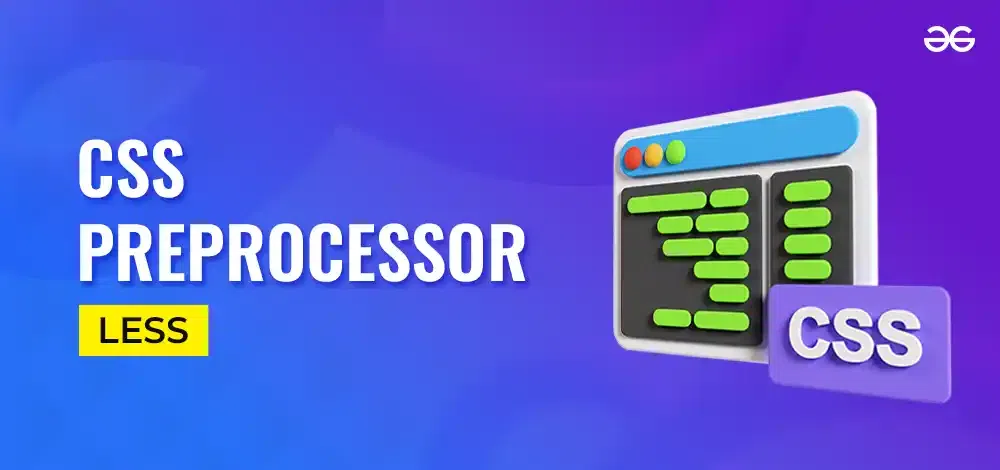CSS Preprocessor LESS (original) (raw)
Last Updated : 09 Jan, 2025
**LESS (Leaner Style Sheets) is a CSS preprocessor that extends CSS with dynamic behavior, including variables, nesting, mixins, and mathematical operations, all while maintaining compatibility with standard CSS.

**Pre-Requisites:
- Basic knowledge of **HTML and **CSS
Key Features of LESS
- **Variables: Store reusable values like colors, fonts, and measurements using the @ symbol.
- **Mixins: Include reusable groups of CSS properties in other rulesets.
- **Nesting: Write CSS in a hierarchical structure reflecting the HTML.
- **Mathematical Operations: Perform arithmetic on CSS values.
- **Functions: Use built-in functions for math, color manipulation, and more.
**System Requirements
- **Operating System: Cross-platform
- **Browser Support: IE (Internet Explorer 8+), Firefox, Google Chrome, Safari.
- **File Type: All LESS files must have the .less file extension.
How LESS Works
A browser cannot directly process LESS code. A LESS preprocessor compiles the LESS file into standard CSS that browsers can interpret.
Working Steps:
- Write the LESS code in a file with a .less extension.
- Compile the LESS file into CSS using the command:
- bash:
* lessc style.less style.css
- bash:
- Include the compiled CSS file in your HTML file.
Here is a list of all the features of LESS, each explained one by one:
**Features:
**1. Variables: Variables can be used to store CSS values that may be reused. They are initialized with _@.
style.less `
@lt-gray: #ddd; @background-dark: #512DA8; @carousel-item-height: 300px; h1 { color:@lt-gray; background:@background-dark; }
`
**Syntax: To compile the above less code to CSS code write the following command-
**lessc style.less style.css
The compiled CSS file comes to be:
style.css `
h1 { color: #ddd; background: #512DA8; }
`
**2. Mixins: Mixins are a way of including a bunch of properties from one rule-set into another rule set.
style.less `
zero-margin { margin:0px auto; background: white; }
.row-header { margin:zero-margin; padding:0px auto; }
.row-content { margin:zero-margin; border-bottom: 1px ridge; min-height:400px; padding: 50px 0px 50px 0px; }
`
**Syntax: To compile the above less code to CSS code write the following command-
lessc style.less style.css
The compiled CSS file comes to be:
style.css `
zero-margin { margin: 0px auto; background: white; } .row-header { margin: zero-margin; padding: 0px auto; } .row-content { margin: zero-margin; border-bottom: 1px ridge; min-height: 400px; padding: 50px 0px 50px 0px; }
`
**3. Nesting: LESS gives you the ability to use nesting.
style.less `
@lt-gray: #ddd; @background-dark: #512DA8; @carousel-item-height: 300px; .carousel { background:@background-dark;
.carousel-item {
height: @carousel-item-height;
img {
position: absolute;
top: 0;
left: 0;
min-height: 300px;
}
}}
`
**Syntax: To compile the above less code to CSS code write the following command-
lessc style.less style.css
The compiled CSS file comes to be:
style.css `
.carousel { background: #512DA8; } .carousel .carousel-item { height: 300px; } .carousel .carousel-item img { position: absolute; top: 0; left: 0; min-height: 300px; }
`
**4. Mathematical Operations: Arithmetical operations +, -, *, / can operate on any number, color, or variable.
style.less `
@lt-gray: #ddd; @background-dark: #512DA8; @carousel-item-height: 300px;
.carousel-item { height: @carousel-item-height; }
.carousel-item .item-large { height: @carousel-item-height *2; }
`
**Syntax: To compile the above less code to CSS code write the following command-
lessc style.less style.css
The compiled CSS file comes to be:
style.css `
.carousel-item { height: 300px; } .carousel-item .item-large { height: 600px; }
`
**5. Functions: LESS provides a variety of functions like math, list, string, color operations, color blending, etc.
style.less ``
@base:0.5; @width: 0.8;
.class {
width: percentage(@width); // Returns 80%
color: saturate(@base, 5%);
background-color: light(@base, 25%), 8;
}
``
**Syntax: To compile the above less code to CSS code write the following command-
lessc style.less style.css
The compiled CSS file comes to be:
style.css `
.class { width: 80%; color: saturate(0.5, 5%); background-color: light(0.5, 25%), 8; }
`
**Example: File name gfg.html
HTML `
- Algo
- DS
- Languages
- Interviews
- CS subjects
style.less
@color-primary: #009900; @font-pri: Sans-Serif; @font-sec: Helvetica;
body{ color: @color-primary; font-size: 40px; }
.list{ font-family: @font-pri; font-size: 20px; .a{ font-family: @font-sec; font-size: 10px; } }
style.css
body { color: #009900; font-size: 40px; } .list { font-family: Sans-Serif; font-size: 20px; } .list .a { font-family: Helvetica; font-size: 10px; }
`
**Output:
**Advantages of LESS
- LESS is cross-browser compatible.
- LESS provides a list of operators making it easy for users to code.
- Maintenance is easy due to the use of variables.
**Disadvantages of LESS
- LESS provides fewer frameworks as compared to SASS.
- It can be tricky to those who are new to CSS.
Best Practices for Using LESS
- **Modularize Your Code: Divide your styles into logical, reusable modules or partials to enhance maintainability.
- **Limit Nesting Levels: Avoid deep nesting to prevent overly specific selectors and maintain readability.
- **Utilize Variables: Define variables for commonly used values like colors and fonts to ensure consistency and simplify updates.
